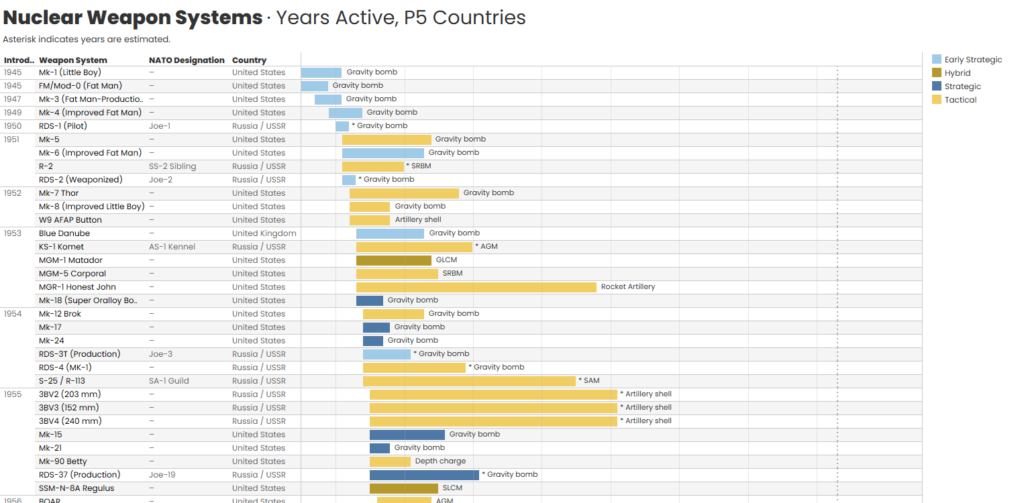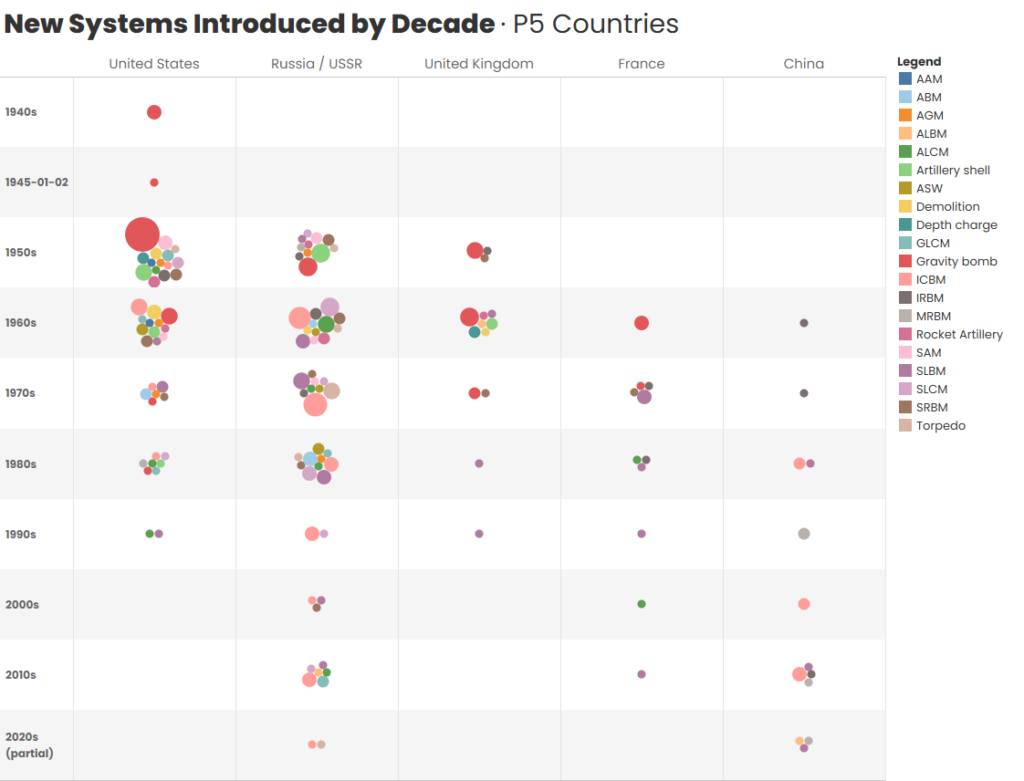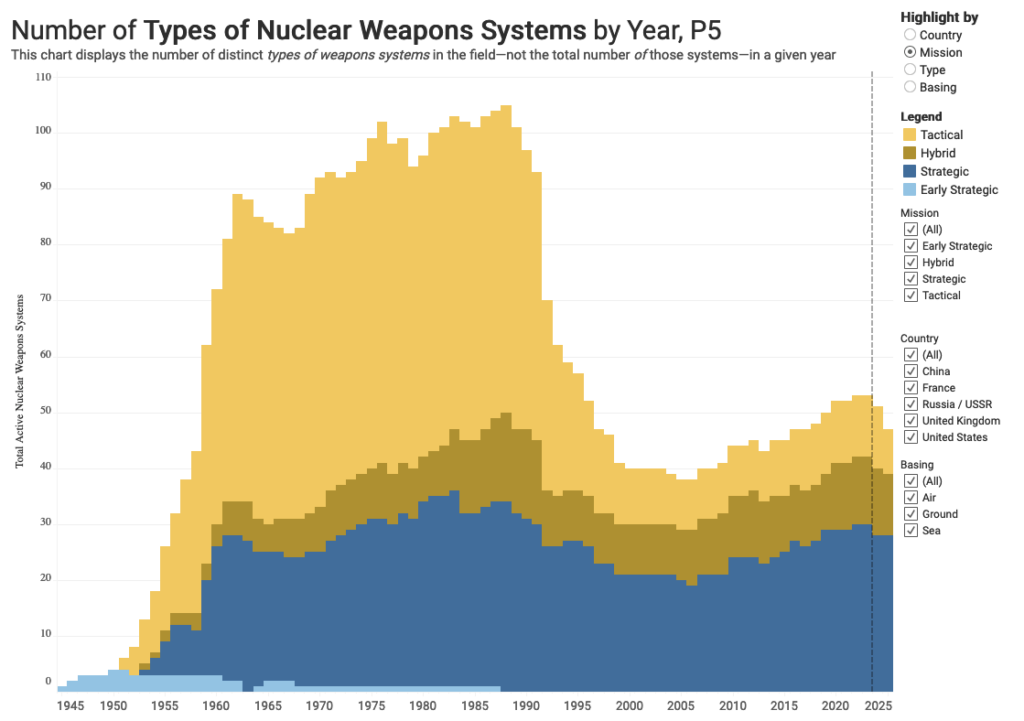New information tool on nuclear weapons seeks to identify the next arms control strategies
By Andrew Facini | December 4, 2023

The way countries view nuclear weapons is shifting. As past arms control measures have ended or decayed, the United States, Russia, and China are investing heavily (again) in their nuclear arsenals, pursuing new capabilities and discarding constraints once seen as fundamentally stabilizing.
For those of us seeking to cultivate nuclear policies geared toward enhancing strategic stability, the current trend reflects a worrying loss of perspective—a forgetting of the hard-earned lessons of the Cold War. To help put today’s trends in their historical context, a team of the Council on Strategic Risks (CSR) developed a new visualization tool and information system that maps every type of nuclear weapon fielded by the five nuclear weapons states (P5) under the Nuclear Non-Proliferation Treaty (NPT)—China, France, Russia, the United Kingdom, and the United States—from their inception to present day.
Launched last week, the Nuclear Weapons Systems Project seeks a “qualitative rethink” by providing a curated data source for all major nuclear delivery systems ever deployed. By seeing more easily what has changed and when, users can better identify the benefits of states’ long trajectory of narrowing the types of nuclear capabilities in the world, understand the risks of a new expansion of nuclear capabilities, and develop ways to de-risk the current situation and prevent future security crises.
Quality vs. quantity. A key foundation for our project is the understanding that the types of nuclear weapons capabilities deployed at any given time matter greatly because they shape the risks of intentional, unauthorized, or accidental use of a nuclear weapon.
These risks were illustrated perhaps most dramatically by the Euromissiles Crisis in the 1980s, when the introduction of new and improved Soviet intermediate-range missiles on its frontier prompted a deployment of similar missiles by the United States in Europe. Just by their mutual presences, the missiles frayed tensions badly and reduced reaction times to mere minutes, marking a new height in the Cold War. But more than their number, it was the new capabilities—that is, the specific qualities—of the Soviet SS-20 and the American Pershing II missiles that shook the strategic stability of Europe and greatly lowered the threshold of an accidental nuclear conflict.
Because numerical limits—counting total warheads or bombers, for example—make it easier to measure progress, they have featured heavily in past arms control agreements, security studies, and policy documents alike. Such quantitative approach of reduction in the overall number of deployed nuclear weapons or launchers has therefore been the backbone of many concepts for future arms control steps. But numerous qualitative risk reduction steps have also been taken by nuclear-armed states over the years; and these proved to be some of the most impactful. The Euromissiles Crisis, for example, famously resulted in the Intermediate-range Nuclear Forces (INF) Treaty, which eliminated that class of missiles which were particularly destabilizing based on their features. (The INF Treaty stood still until Russia violated it and the Trump administration consequently withdrew from it in 2019.)
It was a qualitative approach again when, at the end of the Cold War, the United States and Russia agreed to sharply narrow the types of nuclear weapon systems they fielded. This agreement would contribute to strategic stability by reducing the risk of accidental or unintended use of nuclear weapons while still maintaining both countries’ second-strike capability. In its day, this stability bought the precious time needed to bring about further reductions, as were formalized in New START (the treaty that limits US- and Russian- deployed long-range nuclear forces), enabling both countries to meet their Nuclear Non-Proliferation Treaty Article VI requirements “to pursue negotiations in good faith on effective measures to relating to cessation of the nuclear arms race at an early date and to nuclear disarmament.”
Examining every nuclear weapon type. Tallying up every nuclear weapon system ever deployed by the P5 proved to be both a major analytical undertaking and one that immediately illuminated different dimensions of nuclear policy that had been underexplored and may lead to possible future arms control strategies.
Our search across the American, British, Chinese, French, and Soviet/Russian historical arsenals led to more than 250 distinct types of nuclear weapons systems—from early gravity bombs like the American “Fat Man” to modern dual-capable missiles like Russia’s “Kinzhal,” which has been seen in Ukraine. Once identified, the different nuclear systems were then characterized across dimensions of mission (what kind of target(s) the weapon was intended for), type (e.g., categorizing as bombs, intercontinental ballistic missiles, cruise missiles, artillery shells, demolitions, etc.), and fate (when and why a particular system was retired).
One most surprising fact, which is clearly revealed by our tool, is the proportion of nuclear weapon systems that were given a tactical mission—that is, those pieces of ordnance meant for battlefield use. Just under half of all weapons ever introduced were built for tactical use, introducing unique risks over their operational lifetimes. The broader pivot away from tactical nuclear weapons over the past several decades highly successful in terms of bolstering risk reduction and stability; and it’s clear in our timeline that this approach was a hard-won lesson stemming from some of the Cold War’s most dangerous crises.
Another finding which jumps out visually is just how fervent the early years of the Cold War were in terms of nuclear weapons development. A full 53 percent of all nuclear systems ever deployed were introduced before the end of 1969—that is, during the first 25 years of the nuclear age.
Specific flashpoints, too, were illustrative. During the Cuban Missile Crisis of October 1962, 89 different types of nuclear weapons were available to Washington, Moscow, and London, combined. By 1983 and the Able-Archer war scare, France and China had become nuclear weapons states on their own and the number of nuclear weapon systems available worldwide had climbed to 103. Today, as the war in Ukraine grinds on and potential crises dot the globe, 51 active—deployed and considered ready for use—types of nuclear weapons across the arsenals of the P5 countries, with most of those systems in Russia’s nuclear arsenal only.
New insights. The sum of this data shows a familiar, albeit distinctly important, pattern: As nuclear weapon technologies surged forward, the world entered uniquely dangerous periods in which crises erupted despite a plethora of different nuclear capabilities. Crisis after crisis, steps to control an unchecked arms race were found to be both stabilizing and mutually beneficial—only to be discarded or violated, tempting disaster.
The current moment necessitates qualitative approaches more than ever. Only those can provide a necessary historical understanding of the deployment of nuclear weapon types and inform the future of arms control, restraint, and risk reduction. Russia and China are engaging in significant qualitative changes to their nuclear arsenals and doctrines, and some in the United States are advocating taking a similar path. Our tool can help make sense of the historical consequences of such changes for strategic stability. Perhaps even more important, through this tool, the world can now see clearly the risk of backsliding toward dangerous nuclear capabilities that were previously eliminated, as well as the ways in which states may be willing to agree on preventing the expansion in new types of nuclear capabilities.
Through this project, the CSR team hopes to provide a useful source of information and perspective that can be drawn forward and applied now to help avoid destabilizing actions and limit risk in the future. We invite the open use of the dataset by anyone interested in better understanding the arsenals of the P5 over history. For more on the methodology of our research, its limitations and qualifications, and a list of definitions, please see our launch post.
Together, we make the world safer.
The Bulletin elevates expert voices above the noise. But as an independent nonprofit organization, our operations depend on the support of readers like you. Help us continue to deliver quality journalism that holds leaders accountable. Your support of our work at any level is important. In return, we promise our coverage will be understandable, influential, vigilant, solution-oriented, and fair-minded. Together we can make a difference.
Keywords: P5, arms control, data visualizations, nuclear arsenals, nuclear weapons
Topics: Nuclear Weapons


















International Arms Control agreements ensuring the elimination of nuclear weapons has been impossible [with only limited exceptions] because US leaders listen only to neocons. What hope is there for peace and true national security as long as the White House and Congress is dominated by neo cons?